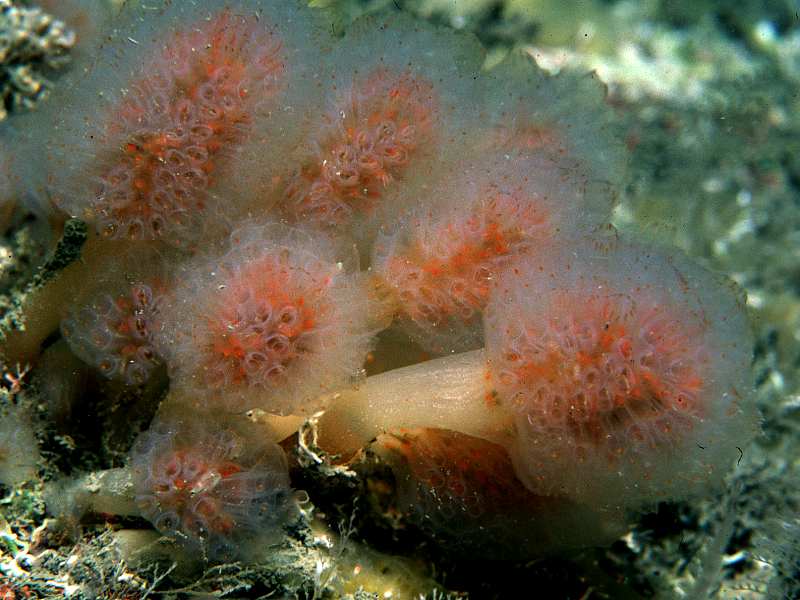| TUNICATA : Aplousobranchia : Polyclinidae | SEA SQUIRTS |
Aplidium punctum (Giard, 1873)
 |
| Aplidium punctum |
Description: Colonies are club-shaped lobes usually with a well developed stalk and a globular head. The test is transparent and individual zooids are greyish with no pigmentation except for an orange spot at the upper part of the endostyle. (In April 1982 all colonies seen in Kilkieran Bay, Co. Galway, had white spots in place of this orange mark; whether this is a widespread feature or not is not known). There is often a pink or orange glow from the interior of the colony. The zooids are irregularly arranged, closely packed, and have long post-abdomens which extend into the stalk of the colony where they appear as pale-coloured fibres. 30mm tall x 10mm diameter head.
Habitat: Very common in areas with considerable water movement, typical of vertical rock faces in shallow water but also found on stones, shells etc. to 20m or more.
Ecology: Apparently overwinters as a small bud. Larvae are produced late in the year, from August onwards, according to Berrill.
Distribution: According to Berrill & Millar this species is south-western in its distribution. Records from E. Scotland would be interesting.
Similar Species: Colonies of Aplidium proliferum may be stalked in some habitats. Morchellium argus also has stalked colonies, but has four spots per zooid.
Key Identification Features:
- Single orange spot in each zooid.
- Stalked, club-shaped colony.
Distribution Map from NBN: Aplidium punctum at National Biodiversity Network mapping facility, data for UK.
iNaturalist: Aplidium punctum at iNaturalist World Species Observations database.
GBIF data for Aplidium punctum
WoRMS: Aplidium punctum at World Register of Marine Species. Accepted name: Aplidium punctum (Giard, 1873). AphiaID: 103662.
Classification: Biota; Animalia; Chordata; Tunicata; Ascidiacea; Aplousobranchia; Polyclinidae; Aplidium
| Previous species | Next species |
| Picton, B.E. & Morrow, C.C. (2024). Aplidium punctum. (Giard, 1873). [In] Encyclopedia of Marine Life of Britain and Ireland. https://www2.habitas.org.uk/marbiop-ni/speciesaccounts.php?item=ZD640. Accessed on 2025-04-10 |